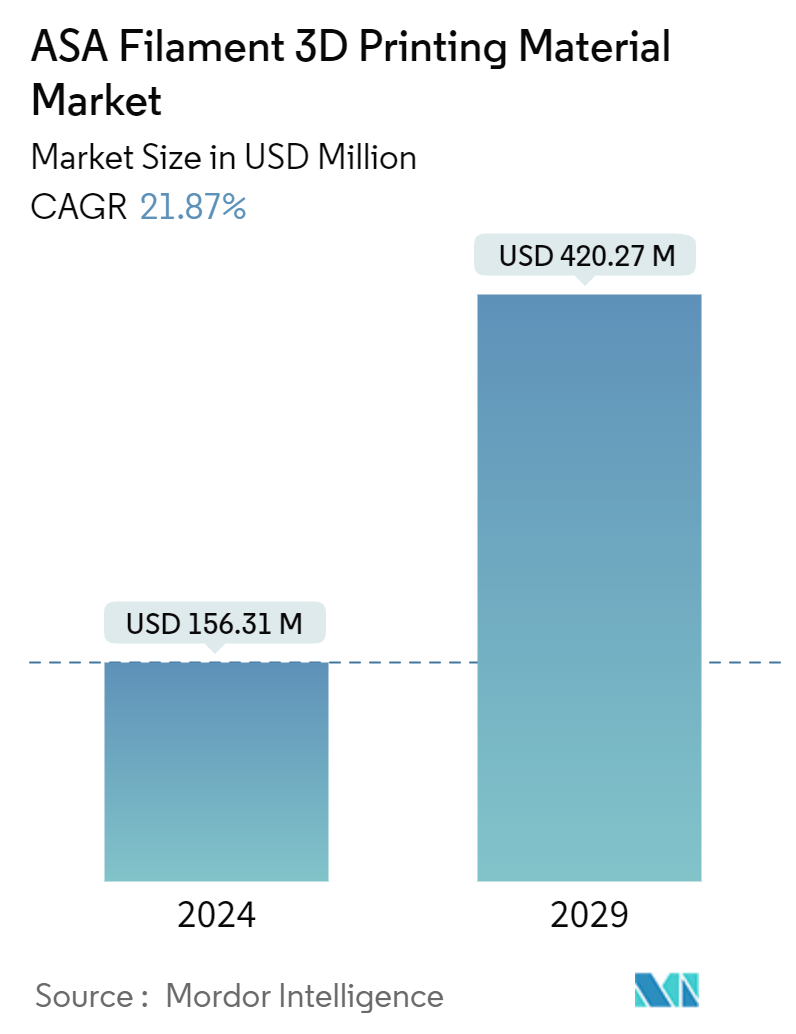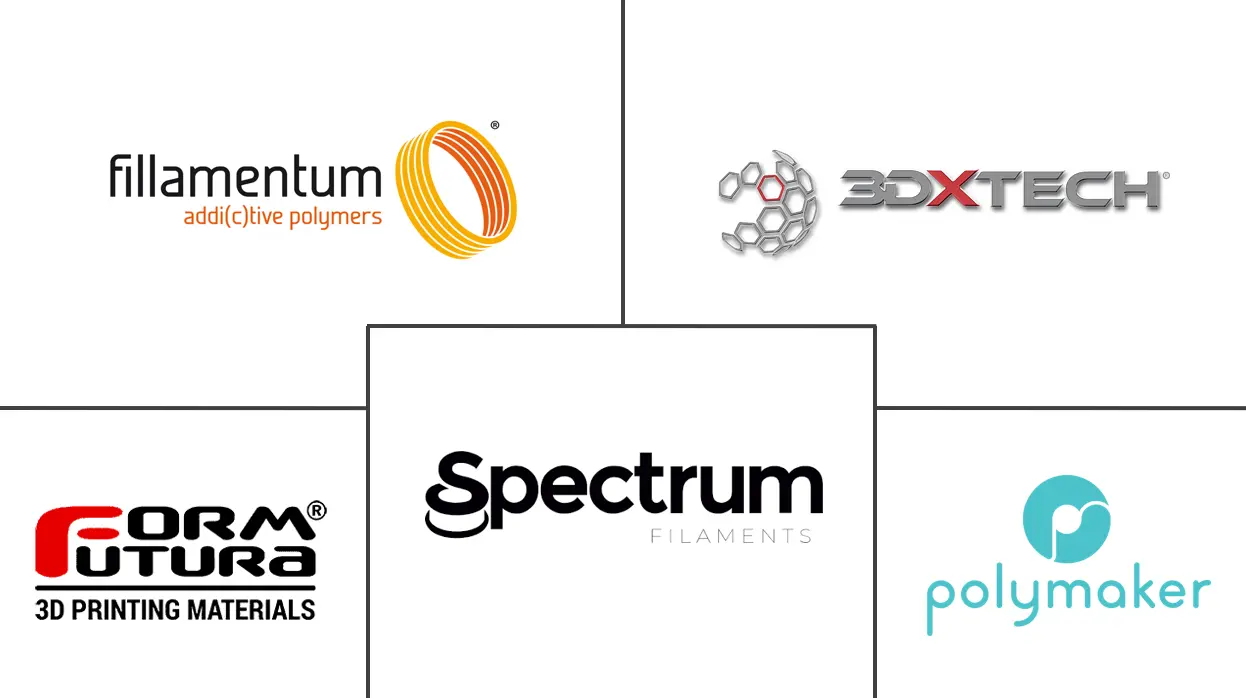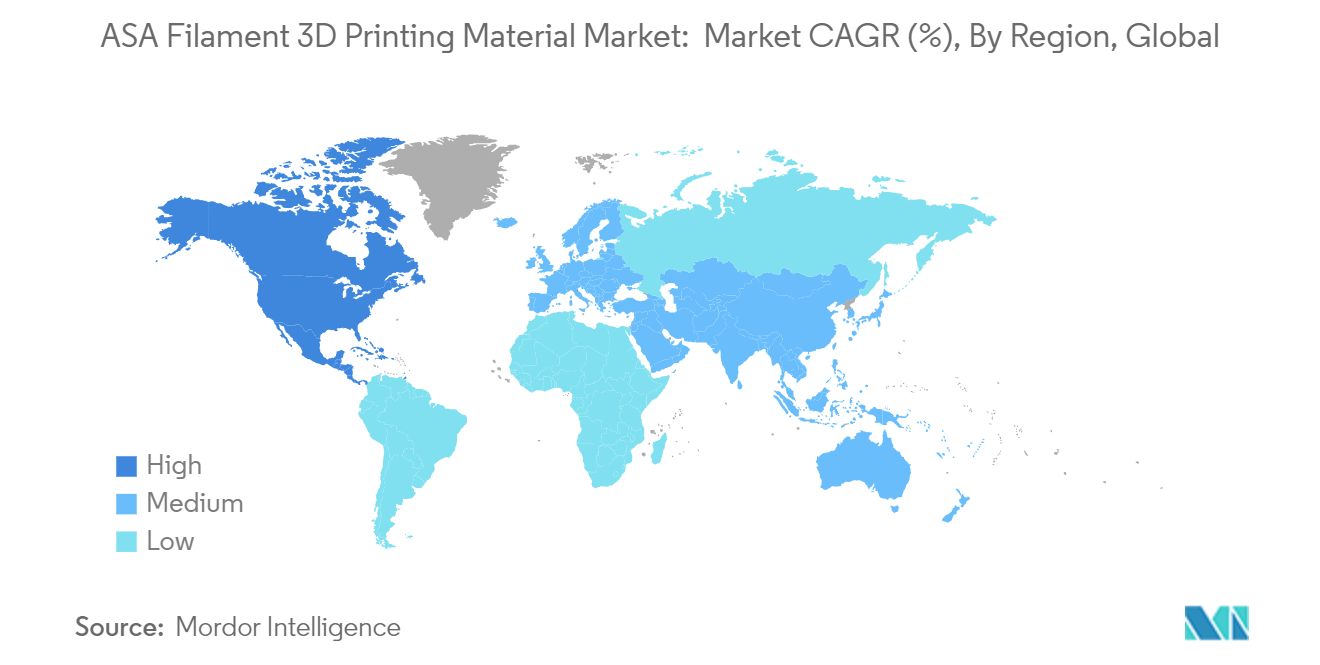ASA Filament 3D Printing Material Market Size

| Study Period | 2019 - 2029 |
| Market Size (2024) | USD 156.31 Million |
| Market Size (2029) | USD 420.27 Million |
| CAGR (2024 - 2029) | 21.87 % |
| Fastest Growing Market | Asia Pacific |
| Largest Market | North America |
| Market Concentration | Medium |
Major Players
*Disclaimer: Major Players sorted in no particular order |
ASA Filament 3D Printing Material Market Analysis
The ASA Filament 3D Printing Material Market size is estimated at USD 156.31 million in 2024, and is expected to reach USD 420.27 million by 2029, growing at a CAGR of 21.87% during the forecast period (2024-2029).
ASA (Acrylonitrile Styrene Acrylate) is a robust thermoplastic filament celebrated for its strength and resistance to weathering. While it shares many traits with ABS, a leading choice in 3D printing filaments, ASA boasts unique advantages. ASA offers commendable temperature resistance, high-impact resilience, and notable toughness like ABS.
• Growing demand for durable, weather-resistant materials in outdoor applications, coupled with the surge in customized manufacturing solutions, significantly drives this growth. Furthermore, the market is witnessing a wave of innovations targeting enhancing ASA filaments' performance, notably in UV resistance and mechanical strength. Such advancements are poised to unlock further avenues for market expansion.
• For instance, industries like automotive and aerospace are increasingly adopting ASA due to its resistance to UV light and weather degradation. These sectors demand durable, lightweight components that endure harsh conditions, making ASA filament ideal for functional prototypes and end-use parts.
• Another significant market driver is the ability to produce customized components via 3D printing. Whether it's personalized outdoor gear or specialized industrial components, ASA filament is gaining traction for applications that require tailored, high-strength solutions. Moreover, fused deposition modeling (FDM) advancements have enhanced control over ASA filament, mitigating previous challenges.
• Companies are innovating with enhanced ASA formulations, focusing on superior UV resistance and better printability. The Asia-Pacific region, especially its manufacturing-centric nations, is witnessing a notable expansion in 3D printing. This growth is fueled by the region's robust industrial foundation and rising investments in cutting-edge manufacturing technologies.
• While ASA offers distinct advantages, its higher cost compared to materials like PLA and ABS poses a challenge, especially in price-sensitive applications and for small businesses. In addition, printing with ASA can be tricky, facing issues like warping and poor adhesion, and due to its styrene content, it emits potentially hazardous fumes.
• Global industrial expansion, especially in the automotive and construction sectors, has positively influenced the ASA filament market. Governments worldwide are investing substantially in advanced manufacturing technologies to promote competitiveness and innovation. These investments, which encompass research grants, subsidies, and public partnerships, are significantly accelerating the adoption of 3D printing technologies.
ASA Filament 3D Printing Material Market Trends
Prototyping Applications to Witness Significant Growth in Adoption of ASA Filaments
- Stratasys, a prominent player in the 3D printing industry, highlights ASA as a versatile prototyping material known for its outstanding UV stability. ASA's resilience against prolonged outdoor exposure makes it particularly ideal for outdoor, commercial, and infrastructure-related production components. Parts crafted with ASA boast accuracy and stability and exhibit remarkable durability.
- Automotive companies increasingly adopt 3D printing for rapid prototyping, enabling quicker design iterations and market entry. ASA filament, known for its resilience against environmental factors like heat and UV light, is preferred for prototyping exterior components, including side mirrors, bumpers, and grilles.
- Furthermore, the rising trend of vehicle personalization has intensified the demand for ASA filaments. As consumers increasingly seek tailored products, manufacturers leverage 3D printing to craft unique prototypes and customized parts in limited runs.
- Rapid prototyping is increasingly being adopted in key sectors such as aerospace and electronics, aiming to accelerate product development without compromising on accuracy and quality. Leveraging 3D printing, this method enables swift and efficient prototype creation. Consequently, manufacturers can identify and rectify design flaws early in the development, enhancing performance and overall product functionality.
- As a result, the forecast period is set to see heightened investments in additive manufacturing techniques for prototyping, fostering a conducive environment for the studied market's expansion. For instance, according to a March 2024 survey by Protolabs, prototyping was the leading use case of 3D printing in 2023.

North America Holds a Significant Market Share
- The North American region is anticipated to remain the prominent region for the ASA filament market during the forecast period due to various factors, including the presence of a relatively stronger local ecosystem for 3D printing and additive manufacturing, a higher awareness among consumers about the benefits of 3D printed parts, and the presence of several vendors offering at various stages of the 3D printing industry value chain, among others.
- North America's automotive industry significantly drives the ASA filament market. With a growing emphasis on lightweight vehicles and customization, automakers increasingly turn to 3D printing technologies to cut production costs and time. Moreover, as the region intensifies its focus on electric vehicles (EVs), the demand for ASA filament is anticipated to surge, given that EVs necessitate lightweight and energy-efficient components.
- For instance, General Motors has been eyeing 3D printing since the late 1980s, initially as a rapid prototyping solution. Their latest offering, the Cadillac Celestiq, an electric ultra-luxury flagship, boasts over a hundred 3D-printed components. These parts range from window switches and grab handles to console decor and structural elements beneath the vehicle's surface. While production volumes remain low, such advancements are poised to accelerate the adoption of 3D-printed exterior vehicle components, bolstering market growth.
- The United States leads the global aerospace sector, with industry giants like Boeing, Lockheed Martin, and SpaceX integrating 3D printing technologies into their manufacturing processes. In a significant move, Boeing plans to test a fully 3D-printed main rotor system for the AH-64 Apache attack helicopter in 2024. In a parallel move, GE Aerospace, in 2024, unveiled plans to channel over USD 650 million into its operations. This investment aims to ramp up production of its 3D printing-enabled LEAP engines and facilitate full-scale production of the GE9X engines, which proudly incorporate over 300 3D-printed parts.
- As ASA filaments, known for their high impact and temperature resistance, can endure mechanical stress over extended periods, they are particularly suited for aerospace applications. Consequently, the robust local ecosystem supporting the aerospace industry in North America bolsters the growth of the studied market.
- Regional investments in 3D printer manufacturing are further propelling the market. In 2024, Prusa Research, a European frontrunner in 3D printers and ASA filaments, declared its North American manufacturing debut via its American subsidiary, Printed Solid. This strategic move aims to cater more effectively to North American clientele. Collaborating with Printed Solid, Prusa is set to produce filaments right in Newark, Delaware.

ASA Filament 3D Printing Material Industry Overview
The competitive landscape is rapidly evolving, shaped by a blend of established players, newcomers, and regional innovators. Intense competition characterizes the market, with companies prioritizing product innovation, enhancing material performance, and expanding regionally to seize greater market share.
With the rising demand for high-performance materials, companies are significantly ramping up their R&D investments. Industry leaders are homing in to produce premium filaments tailored for sectors prioritizing outdoor durability and aesthetic appeal. Notable filament producers in the forefront include BASF Forward AM, 3DXTech, and Polymaker.
Companies should emphasize innovation and distinct product offerings to carve a niche in the ASA filament 3D printing arena. Strategic alliances with 3D printer manufacturers can lead to optimized compatibility and an enriched customer experience. Targeting high-growth regions, particularly in the Asia-Pacific, is crucial. Moreover, embracing sustainable practices meets environmental standards and resonates with today's conscientious consumers. Striking a balance between competitive pricing and unwavering quality can broaden the customer base.
ASA Filament 3D Printing Material Market Leaders
-
Fillamentum
-
FormFutura
-
Polymaker
-
3DXTech
-
Spectrum Filaments
*Disclaimer: Major Players sorted in no particular order

ASA Filament 3D Printing Material Market News
- July 2024: Sydney, Australia, inaugurated a facility focused on transforming hard plastics from electronic waste into 3D printing filament. This facility, a collaboration between the University of New South Wales (UNSW) and IT asset management firm Renew IT, marks a pivotal move towards sustainable waste management. Situated in Lane Cove, New South Wales, the facility boasts the advanced Plastics Filament MICROfactorie Technology, a brainchild of UNSW's Centre for Sustainable Materials Research & Technology (SMaRT). This innovative technology adeptly converts hard plastic waste, often sourced from electronic devices, into a valuable material for 3D printing.
- June 2024: Raise3D, a prominent 3D printer manufacturer, unveiled its latest series, the Pro3 HS, which utilizes Fused Filament Fabrication (FFF) technology. Alongside this launch, the company introduced the Hyper Core Filament Line. The Pro3 HS Series, featuring an advanced motion control system, boasts enhanced speed, precision, and accuracy, making it ideal for efficiently manufacturing large composite components. In addition, the printer is versatile, supporting a range of materials, including ASA filament.
ASA Filament 3D Printing Material Market Report - Table of Contents
1. INTRODUCTION
1.1 Study Assumptions and Market Definition
1.2 Scope of the Study
2. RESEARCH METHODOLOGY
3. EXECUTIVE SUMMARY
4. MARKET INSIGHTS
4.1 Market Overview
4.2 Industry Attractiveness - Porter's Five Forces Analysis
4.2.1 Bargaining Power of Suppliers
4.2.2 Bargaining Power of Consumers
4.2.3 Threat of New Entrants
4.2.4 Threat of Substitutes
4.2.5 Intensity of Competitive Rivalry
4.3 An Assessment of Impact of Macroeconomic Trends on The Market
5. MARKET DYNAMICS
5.1 Market Drivers
5.1.1 Growing Demand for 3D Printed Products With Durable Outdoor Application
5.1.2 Growing Proliferation of 3D Printing Technology Across Various Sectors
5.2 Market Restraints
5.2.1 Technical Limications and High Material Cost
6. MARKET SEGMENTATION
6.1 By Diameter
6.1.1 Standard (1.75mm)
6.1.2 Large (2.85mm, 3mm)
6.2 By Application
6.2.1 Prototyping
6.2.2 Tooling
6.2.3 Production Parts
6.2.4 Others
6.3 By Geography***
6.3.1 North America
6.3.2 Europe
6.3.3 Asia
6.3.4 Australia and New Zealand
6.3.5 Latin America
6.3.6 Middle East and Africa
7. COMPETITIVE LANDSCAPE
7.1 Company Profiles
7.1.1 Forward AM Technologies GmbH
7.1.2 Prusa Polymers a.s.
7.1.3 Fillamentum
7.1.4 FormFutura
7.1.5 Polymaker
7.1.6 3DXTech
7.1.7 Shenzhen Esun Industrial Co., Ltd
7.1.8 Spectrum Filaments
7.1.9 Kimya (Armor Group)
7.1.10 MatterHackers Inc.
7.1.11 ProtoPlant Inc.
7.1.12 Overture 3D
7.1.13 BigRep
- *List Not Exhaustive
8. INVESTMENT ANALYSIS
9. FUTURE OF THE MARKET
ASA Filament 3D Printing Material Industry Segmentation
Acrylonitrile Styrene Acrylate (ASA) filament is a thermoplastic used in 3D printing. It is valued for its superior weather, UV, and impact resistance. It shares similarities with ABS (Acrylonitrile Butadiene Styrene) but is more durable outdoors, making it ideal for parts exposed to sunlight and harsh weather conditions.
The study tracks the revenue generated from various manufacturers worldwide selling ASA filaments. It also tracks the key market parameters, underlying growth influencers, and major manufacturers operating in the industry, which supports the market estimations and growth rates over the forecast period. The study further analyses the overall impact of macroeconomic factors on the market. The report’s scope encompasses market sizing and forecasts for the various market segments.
The ASA filament 3D printing material market is segmented by diameter (standard (1.75mm), large (2.85mm, 3mm)), application (prototyping, tooling, production parts, others), and geography (North America, Europe, Asia-Pacific, Latin America, and Middle East and Africa). The market sizes and forecasts are provided in terms of value (USD) for all the above segments.
| By Diameter | |
| Standard (1.75mm) | |
| Large (2.85mm, 3mm) |
| By Application | |
| Prototyping | |
| Tooling | |
| Production Parts | |
| Others |
| By Geography*** | |
| North America | |
| Europe | |
| Asia | |
| Australia and New Zealand | |
| Latin America | |
| Middle East and Africa |
ASA Filament 3D Printing Material Market Research FAQs
How big is the ASA Filament 3D Printing Material Market?
The ASA Filament 3D Printing Material Market size is expected to reach USD 156.31 million in 2024 and grow at a CAGR of 21.87% to reach USD 420.27 million by 2029.
What is the current ASA Filament 3D Printing Material Market size?
In 2024, the ASA Filament 3D Printing Material Market size is expected to reach USD 156.31 million.
Who are the key players in ASA Filament 3D Printing Material Market?
Fillamentum, FormFutura, Polymaker, 3DXTech and Spectrum Filaments are the major companies operating in the ASA Filament 3D Printing Material Market.
Which is the fastest growing region in ASA Filament 3D Printing Material Market?
Asia Pacific is estimated to grow at the highest CAGR over the forecast period (2024-2029).
Which region has the biggest share in ASA Filament 3D Printing Material Market?
In 2024, the North America accounts for the largest market share in ASA Filament 3D Printing Material Market.
What years does this ASA Filament 3D Printing Material Market cover, and what was the market size in 2023?
In 2023, the ASA Filament 3D Printing Material Market size was estimated at USD 122.13 million. The report covers the ASA Filament 3D Printing Material Market historical market size for years: 2019, 2020, 2021, 2022 and 2023. The report also forecasts the ASA Filament 3D Printing Material Market size for years: 2024, 2025, 2026, 2027, 2028 and 2029.
ASA Filament 3D Printing Material Industry Report
Statistics for the 2024 ASA Filament 3D Printing Material market share, size and revenue growth rate, created by Mordor Intelligence™ Industry Reports. ASA Filament 3D Printing Material analysis includes a market forecast outlook for 2024 to 2029 and historical overview. Get a sample of this industry analysis as a free report PDF download.



